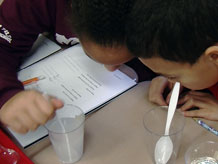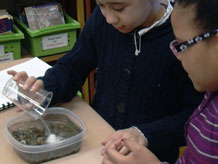What changes and what stays the same when salt dissolves in water?
4. Dissolve salt in water
Tracking dissolved salt using weight

Distribute the second set of materials to the groups.
The Science Notebook page [What happens when salt dissolves in water?] will guide students through the process of weighing the water, salt, and the water with the salt added, and tracking changes in the volume.
- Review the concept of tare weight. Call attention to the tare weight of the cup, which you have posted.
- Show students where to put a piece of masking tape on the water cup so they can mark the water level before adding the salt.
- Review the notebook page that sets out the procedure for recording the weights. The weight data will be numerical (grams); the volume data will be visual (labeled drawings).
- Students will discuss their findings after they weigh their mini-lakes.
As students finish collecting and recording the data, collect the 12oz cups of salt water and have students get their mini-lakes.
Transforming mini-lakes to Salt Lakes

Students have probably heard about the Great Salt Lake in Utah. They'll now have the opportunity to transform their mini-lakes into Mini Salt Lakes by adding two teaspoons of salt.
Tell students they'll need to weigh their mini-lakes twice: once before adding the salt and once after adding the salt.
Distribute the third set of materials, 1 12oz cup holding approximately 20g of salt, to each pair.
Each pair:
- Weigh mini-lake and record weight in Science Notebook.
- Pour salt into mini-lake. Don't stir.
- Re-weigh mini-lake and record weight in Science Notebook. Add a note about addition of salt.
- Calculate the weight of the salt added to the mini-lake and record in Science Notebook.



